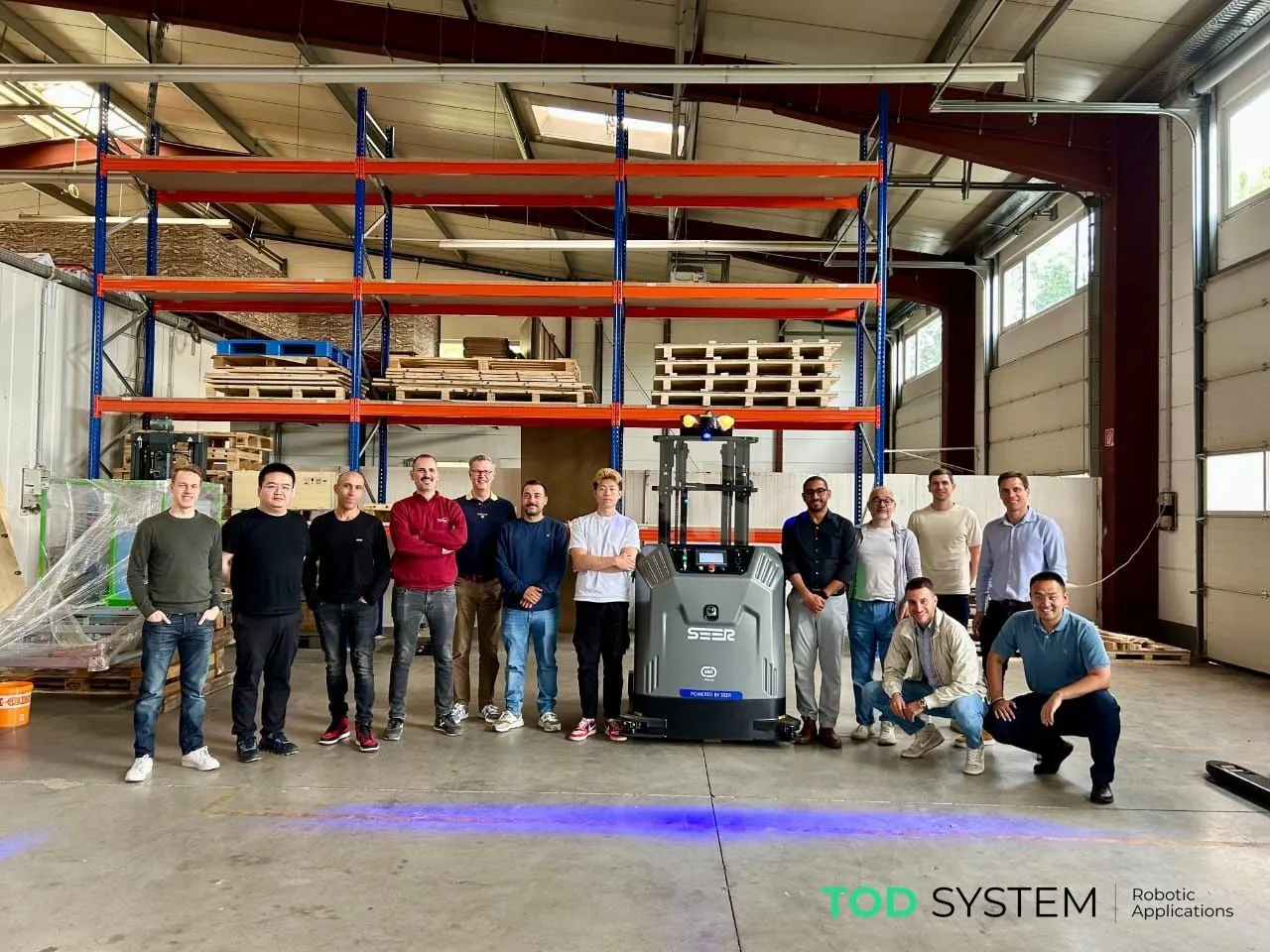Content index
ToggleIn recent years, the growing demand for operational efficiency and the need to reduce costs have prompted many companies to invest in automation technologies for warehouse management. Among the most innovative and adopted solutions are the palletisers are a key element in the optimisation of internal logistics.
These advanced machines are designed to automate the process of stacking goods on palletssignificantly reducing the manual workload and improving the organisation of available space. Thanks to the integration of intelligent software and the latest generation of sensors, palletisers guarantee high precision in the arrangement of products, avoiding damage to goods and ensuring safer and more efficient handling.
The adoption of these systems offers multiple benefitsincluding an increase in productivity, a reduction in human error and an improvement in the working conditions of operators, who can be assigned to higher value-added tasks. In addition, palletisers contribute to a more rational management of warehouse space, facilitating the transport and distribution of goods.
But what makes these tools so indispensable in modern logistics? In this article, we will delve into how they work, the different types available, the benefits for companies and their impact on productivity, highlighting how their implementation can radically transform warehouse operations.
1. What are Palletisers and How Do They Work?
THE palletisers are machines designed to automate the process of stacking products neatly and safely on pallets, thus facilitating storage and transport operations. In the past, this activity was carried out manually by operators, but with the advancement of industrial automation, it is now entrusted to robotic systems, intelligent sensors and advanced softwarewhich guarantee greater efficiency, precision and safety.
The operation of a palletiser involves the sampling of products directly from a production line or from an internal transport system. Once received, the products are arranged on the pallet following predefined patterns that guarantee stability and safety during handling. This process optimises space management, reduces the risk of damage to goods and speeds up logistics operations.
1.1 Main Components of a Palletiser
A palletiser consists of several fundamental elements, each with a specific role in ensuring efficient and precise operation:
- Feeding system: conveys products from the production line to the palletising area, ensuring a continuous and smooth flow.
- Positioning unit: organises the products in the desired arrangement before stacking, optimising the layout to ensure stability.
- Robotic arm or stacking mechanism: picks up the products and places them on the pallet following a predefined pattern, which may vary according to the type of goods and handling requirements.
Control software: manages the entire process, allowing the programming of different stacking patterns, monitoring of operations and adjustment of working speed according to production demand.
2. Types of Palletisers
Palletisers fall into different categories, each designed to meet specific industrial needs. The choice of palletiser type depends on factors such as production volume, level of automation required, type of products to be handled and available warehouse space.
2.1 Automatic Palletisers
THE automatic palletisers are fully autonomous machines, capable of handling the entire stacking process without the need for human intervention. They are equipped with Robotic arms, advanced sensors and intelligent software that guarantee precise and continuous operation.
Advantages of automatic palletisers
- Greater productivityThey operate without interruption, optimising processing times.
- Fewer errorsThey reduce the risk of human error, ensuring a more stable arrangement of products on pallets.
- Integration with management systemscan be connected to WMS (Warehouse Management System) and ERP (Enterprise Resource Planning)improving the business workflow.
- Improved securityThey eliminate the need for heavy manual handling, reducing the risk of injury to operators.
These systems are ideal for companies with high production volumes in need of a constant, automated workflow.
2.2 Semi-Automatic Palletisers
THE semi-automatic palletisers represent an intermediate solution between fully automated and manual systems. In these systems, certain process steps are managed automaticallywhile others still require the intervention of an operatore.g. for the initial positioning of products or replacement of pallets.
Advantages of semi-automatic palletisers:
- Lower costs compared to fully automatic models.
- Greater flexibility for companies with low production volumes or variable requirements.
- Ease of usewith an intuitive interface for operators.
These palletisers are particularly suitable for small and medium-sized companieswhere full automation may not be cost-effective.
2.3 Robotic Palletisers
THE robotic palletisers represent the most advanced technology in the palletising sector. They use mechanical arms controlled by intelligent software to pick up, rotate and position products with extreme precision.
Advantages of robot palletisers:
- High precision and versatilityrobots can adapt to complex stacking patterns and work with products of different shapes and sizes.
- Ability to adapt to different product formatsautomatically adjusting the grip and arrangement on the pallet.
- Seamless integration with other automated technologies, such as conveyors, machine vision systems and warehouse management software.
- Space optimisationthanks to fluid, millimetre-calculated movements.
Robotic palletisers are ideal for companies with high precision and variability requirements in the type of products handled. Their flexibility makes them a strategic solution for the future of industrial logistics.
3. Advantages of Using a Palletiser in the Warehouse
The introduction of a palletiser in logistics processes offers a number of strategic advantages that improve goods management, optimise operations and reduce costs. These automated systems enable companies to increase productivity, improve work safety and make more efficient use of warehouse space.
3.1 Increased Efficiency and Productivity
One of the main advantages of using a palletiser is its ability to operate continuously, 24 hours a daywithout pauses or drops in performance. This translates into a increased speed in the goods handling processreducing waiting times and improving the workflow.
In addition, thanks to theoptimised product stacking, the palletiser allows make better use of available spacefacilitating loading and unloading operations and speeding up shipping times. The reduction of manual operations also allows personnel to be allocated to higher value-added activities.
3.2 Reducing Errors and Discards
The manual arrangement of products on pallets may be subject to misalignment errors, incorrect positioning and load instabilityleading to product damage and material waste.
Automation guarantees precise and repeatable stacking patternsThis minimises the risk of errors and improves the integrity of the goods. A palletiser ensures that each pallet is uniformly formedpreventing breakage during transport and contributing to the reduction of waste.
3.3 Increased Safety at Work
Manual handling of heavy loads is a significant risk factor for warehouse operators, with the possibility of musculoskeletal injuries, fatigue and accidents at work.
The use of a palletiser drastically reduces the need for human intervention in the stacking phase, improving the safety of the working environment. Operators no longer have to lift heavy loads or perform repetitive and potentially harmful movements, contributing to a more ergonomic and safer working environment.
3.4 Warehouse Space Optimisation
One of the most common problems in warehouse management is theinefficient use of available space. Palletisers allow stack goods neatly and compactlymaking the most of storage heights and facilitating handling operations.
A more efficient organisation makes it possible to reduce unused storage areas, improve accessibility to goods and make picking and loading easier. This leads to smoother logistics and more effective inventory management.
3.5 Reducing Operating Costs
The automation of the palletising process leads to a significant reduction of labour-related costs. Since the system can operate autonomously, the number of operators required for this process step can be reduced, lowering personnel costs and improving overall efficiency.
In addition, thanks to reduced errors, increased execution speed and space optimisation, companies can achieve a faster return on investment (ROI)improving the overall profitability of warehouse operations.
4. Integration with Other Automation Systems
A modern palletiser does not operate in isolation, but can be seamlessly integrated with other automation technologies to optimise the entire logistics cycle. The interconnection between machinery and software improves productivity, reduces handling time and ensures a smoother and more efficient workflow.
The integration of a palletiser with warehouse management systems and autonomous vehicles is a key step towards making logistics more and more intelligent and interconnected.
4.1 Integration with the WMS (Warehouse Management System)
The Warehouse Management System (WMS) is an advanced software used for monitor and manage all operations within a warehouse, from receipt of goods to dispatch.
When a palletiser is connected to a WMS, more efficient management of inventory and logistics operations can be achieved. The system can:
- Coordinating the work of the palletiser with other warehouse activities, such as picking and packing.
- Tracking pallets in real timeidentifying their location and content.
- Optimising storage and shipping processesensuring that each pallet is prepared according to order requirements.
- Reducing human errors through the automated management of information and workflows.
Thanks to this integration, the warehouse becomes more intelligent, organised and responsivewith a reduction in downtime and an increase in overall productivity.
4.2 Interaction with AGVs and AMRs
THE automated guided vehicles (AGVs) hey autonomous mobile robots (AMR) are increasingly used in automated warehouses for transport completed pallets to storage or shipping areas.
A palletiser can be programmed to communicate directly with these systems, creating a fully automated workflow:
- Palletiser completes product layout on a pallet according to the required specifications.
- An AGV or AMR receives the pick-up signal and approaches the palletising station.
- The robot picks up the pallet and transports it to its final destination, which may be a storage area or a loading zone for shipment.
- The WMS automatically updates the status of the palletensuring real-time monitoring of the goods.
This interaction enables a seamless workflowimproving the management of internal logistics and minimising human intervention in the most tiring and repetitive operations.
5. The Future of Palletisation: Innovation and Sustainability
5. The Future of Palletisation: Innovation and Sustainability
Automation in the logistics sector is constantly evolving, and palletising systems are no exception. New technologies are redefining the way goods are handled and stored, improving operational efficiency and reducing environmental impact.
The future of palletisation will be driven by three main directions: the introduction of increasingly intelligent and collaborative robots, the advanced integration of artificial intelligence and an increased focus on sustainability.
5.1 Intelligent and Collaborative Robots
The use of collaborative robots (cobots) is becoming increasingly common in palletising processes. Unlike traditional robots, cobots are designed to working in synergy with human operatorsimproving the flexibility and security of operations.
The main advantages of cobots in palletising include:
- Greater adaptabilitycobots can be easily reprogrammed to handle different types of products and pallet configurations.
- Improved securityThanks to advanced sensors and collision detection systems, cobots can operate alongside operators without physical barriers of protection.
- Increased productivitycollaborative robots can perform the most repetitive and heavy tasks, allowing operators to concentrate on more value-added activities.
This new generation of robots will make palletising operations more efficient, flexible and securequickly adapting to the needs of companies.
5.2 Increased Use of Artificial Intelligence
Artificial intelligence (AI) is revolutionising the logistics industry, and palletising is no exception. Thanks to machine learning algorithms, palletisers of the future will be able to optimise their operation in real timedynamically adapting to changes in production lines.
Some examples of the application of AI in palletising include:
- Automatic optimisation of load configurationsto maximise the space available on the pallets.
- Predictive analysis to identify any anomalies in the process and prevent failures or inefficiencies.
- Continuous learningwhich allows systems to improve their performance as they process more data.
This evolution will make palletisers more intelligent and autonomoushelping to reduce operating costs and improve service quality.
5.3 Sustainability and Waste Reduction
Another crucial aspect of the future of palletisation concerns the sustainability. Companies are increasingly looking for solutions that reduce environmental impact and optimise resource consumption.
The main innovations in this area include:
- Reducing energy consumptionThe new palletising systems will use energy-efficient motors and components with energy recovery technologies.
- Optimisation of packaging materialsThanks to advanced software, it will be possible to reduce the use of plastic and other packaging materials and minimise waste.
- Green automationintegration with sustainable production facilities and renewable energy sources will make palletising processes more environmentally friendly.
These innovations will not only help to improve theoperational efficiencybut will allow companies to comply with increasingly stringent environmental regulations and improve their image on the market.
6. Conclusion: Why Implement a Palletiser in Your Warehouse?
Automation has become a key element for companies wishing to optimise logistics operations, reduce costs and improve safety at work. The adoption of a palletiser is a strategic choice for any company that wants to remain competitive in the global market, thanks to the many benefits this technology offers.
6.1 An Investment for Business Growth
The introduction of a palletiser in the warehouse brings tangible benefits, including:
- Greater operational efficiencywith an acceleration of the loading and unloading processes.
- Improving securityreducing the risk of accidents related to manual handling of loads.
- Optimisation of storage spacethanks to more precise and structured stacking.
- Reducing errors and wastedue to the high precision of the automated systems.
- Cutting operating costsreducing the need for labour for repetitive and low value-added activities.
6.2 Tailor-made Automation for Your Warehouse
Every company has specific needs and choosing the right palletiser requires a careful analysis of its logistics operations. The solutions available today allow for a high level of customisation, thanks to integration with warehouse management systems (WMS), automated guided vehicles (AGVs) and artificial intelligence-based technologies.
6.3 TOD SYSTEM LTD: The Partner for Your Logistics Automation
If you want to take your warehouse to the next level, TOD SYSTEM SRL is the ideal partner to guide you in choosing and implementing the solution best suited to your needs. We offer personalised advice, tailor-made solutions and state-of-the-art technology to help you improve your company's efficiency and productivity.
📞 Contact us today for a consultation and discover how automation can transform your warehouse!






